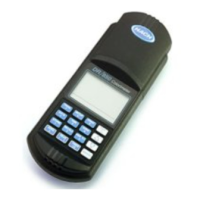352
Method Performance
Precision
In a single laboratory using a standard solution of 1.00 mg/L
PO
4
3-
and two lots of reagents with the instrument, a single
operator obtained a standard deviation of ±0.05 mg/L PO
4
3-
.
In a single laboratory using a standard solution of 1.00 mg/L
PO
4
3-
and two representative lots of AccuVac ampuls with the
instrument, a single operator obtained a standard deviation of
±0.03 mg/L PO
4
3-
.
Estimated Detection Limit (EDL)
The EDL for program 79 is 0.05 mg/L PO
4
. For more information
on the estimated detection limit, see Section 1.
Interference
Summary of Method
Orthophosphate reacts with molybdate in an acid medium to
produce a Phosphomolybdate complex. Ascorbic acid then
reduces the complex, giving an intense molybdenum blue color.
Interfering Substance Interference Levels and Treatments
Aluminum Greater than 200 mg/L
Arsenate All levels
Chromium Greater than 100 mg/L
Copper Greater than 10 mg/L
Hydrogen sulfide All levels
Iron Greater than 100 mg/L
Nickel Greater than 300 mg/L
Silica Greater than 50 mg/L
Silicate Greater than 10 mg/L
Turbidity or color Large amounts may cause inconsistent results in the test
because the acid present in the powder pillows may dissolve
some of the suspended particles and because of variable
desorption of orthophosphate from the particles. For highly
turbid or colored samples, add the contents of one Phosphate
Pretreatment Pillow to 25 mL of sample. Mix well. Use this
solution to zero the instrument.
Zinc Greater than 80 mg/L
Highly buffered
samples or extreme
sample pH
May exceed the buffering capacity of the reagents and require
sample pretreatment.
pH 2 to 10 is recommended.
PHOSPHORUS, REACTIVE, continued

